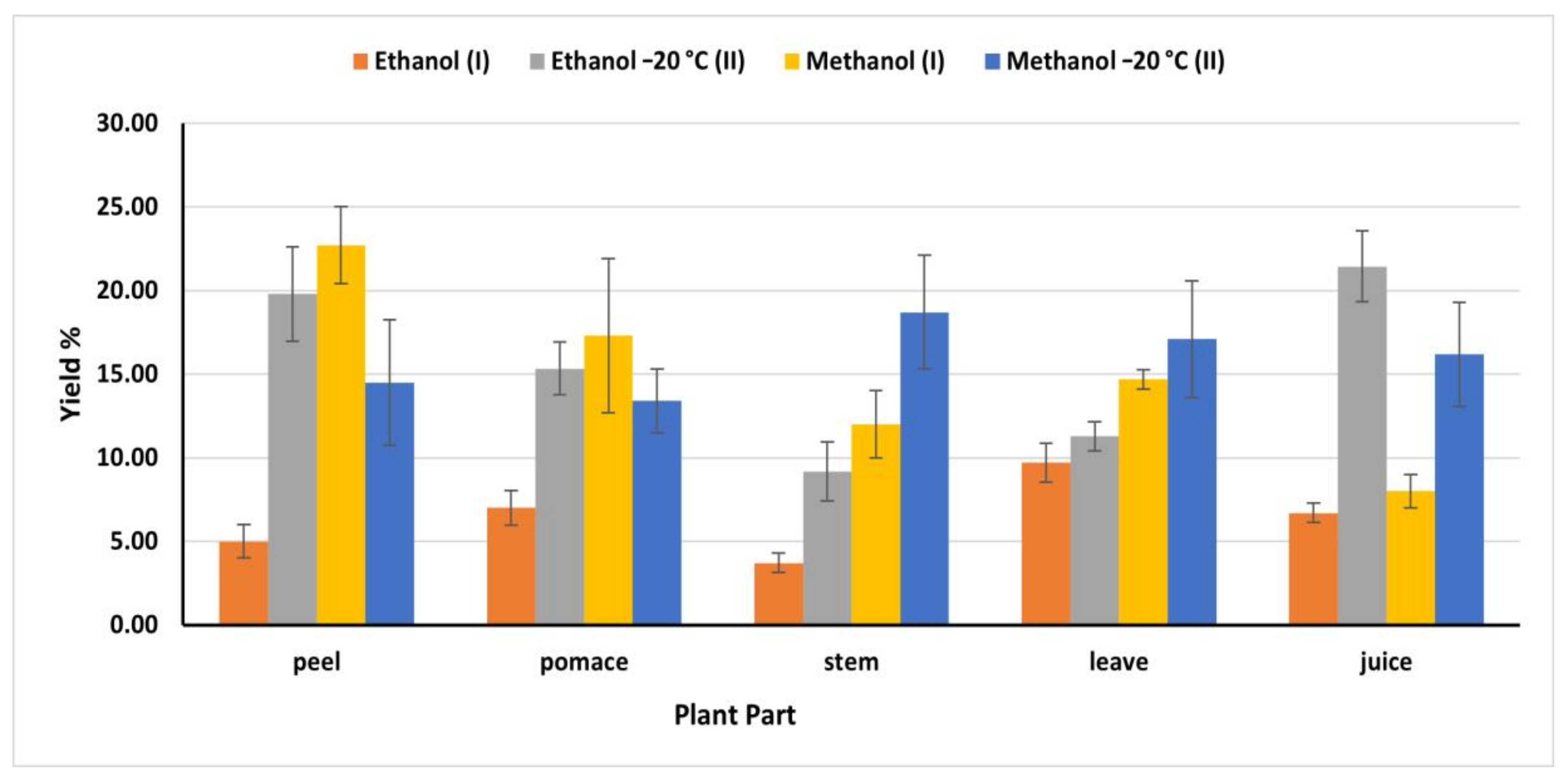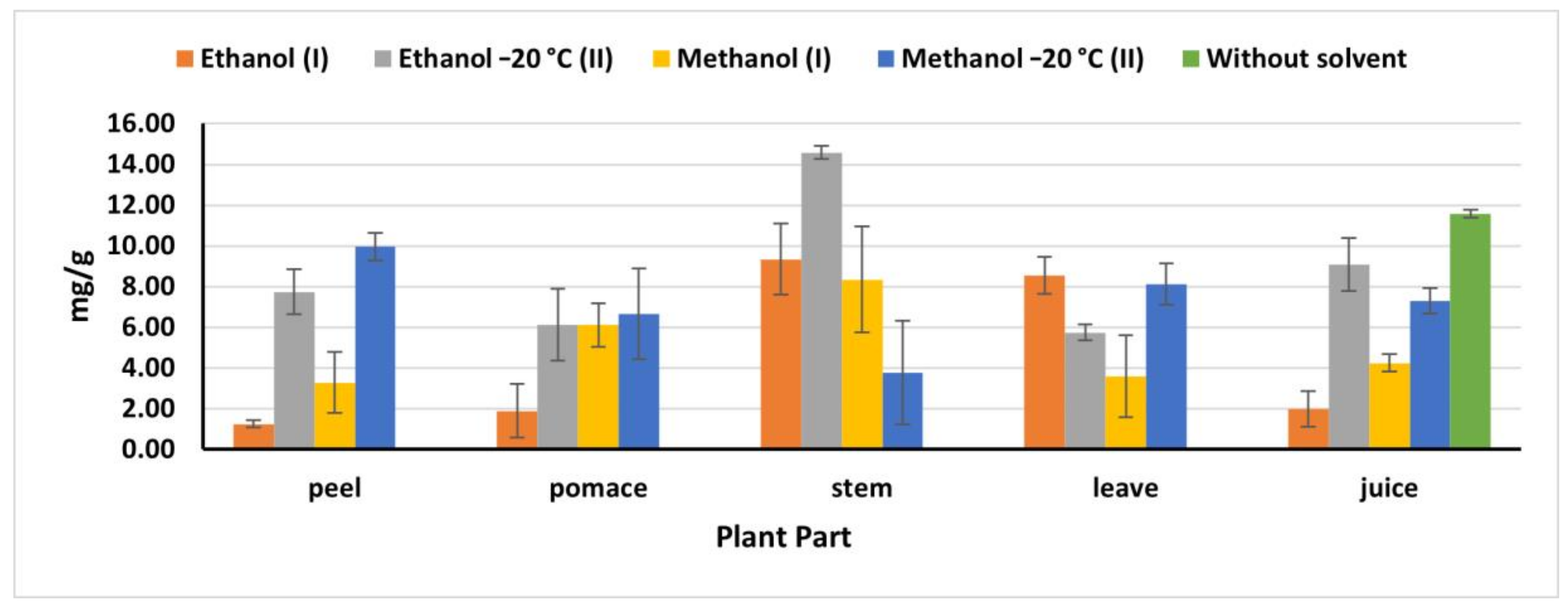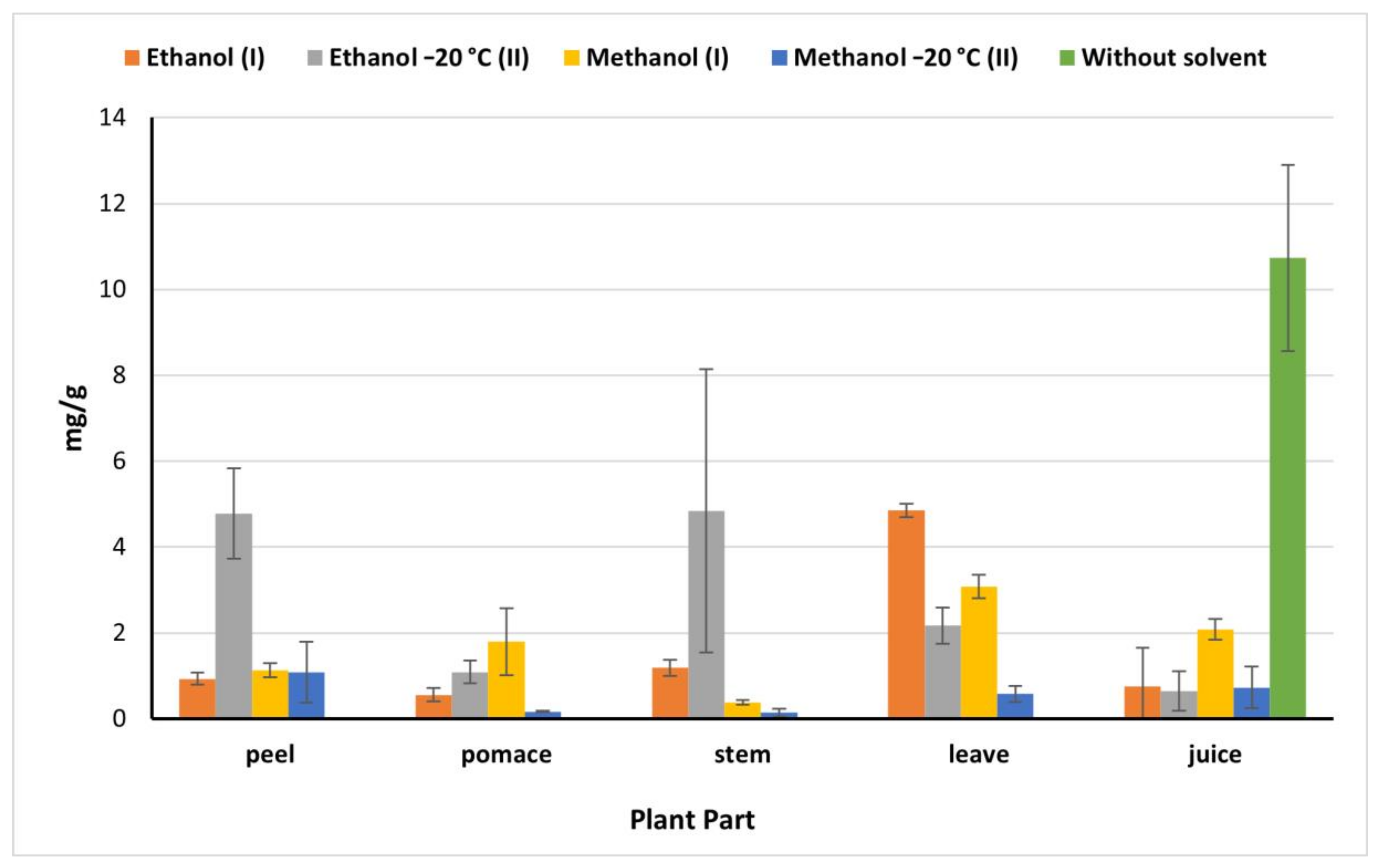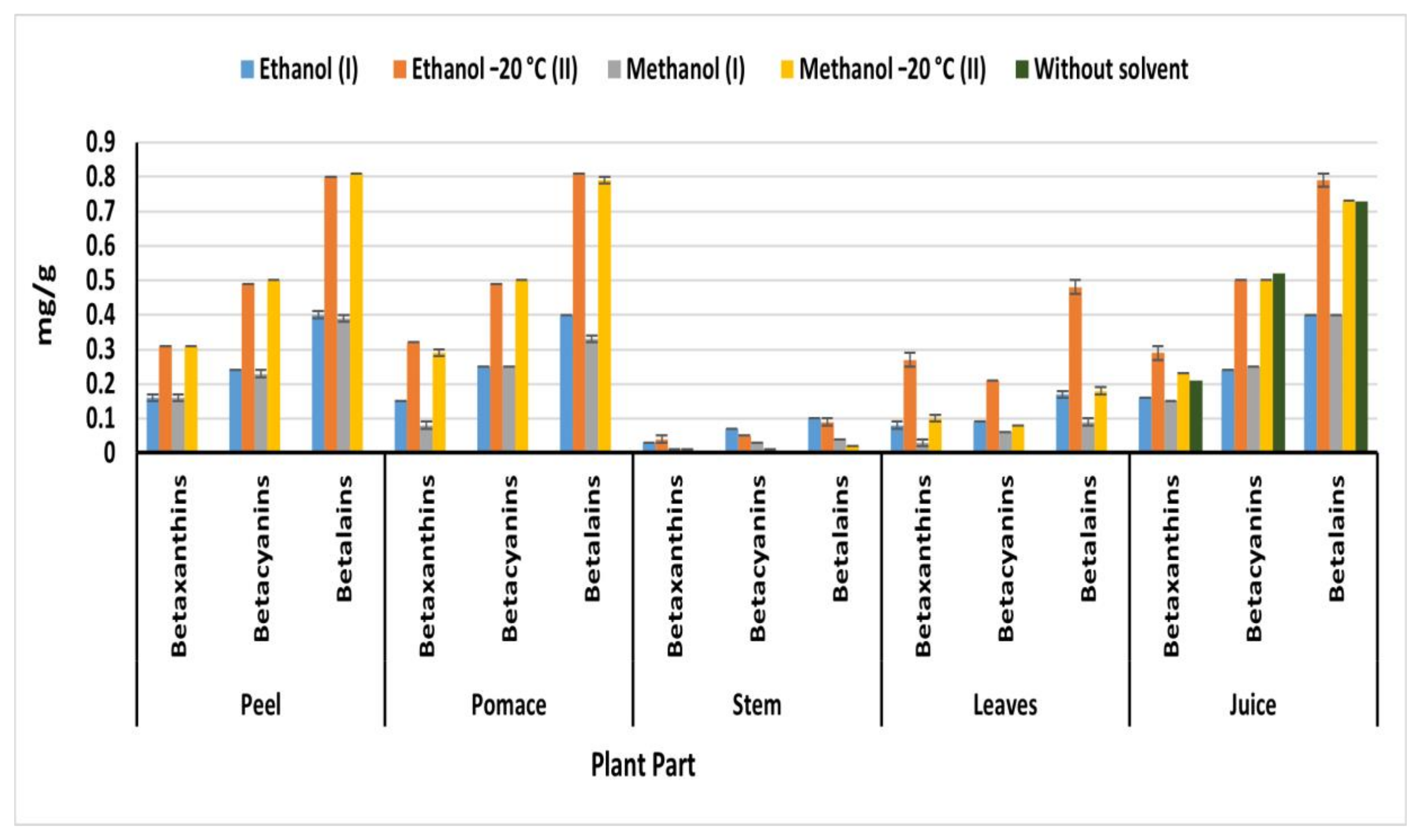Nutritional Evaluation of Beetroots (Beta vulgaris L.) and Its Potential Application in a Functional Beverage
Abstract
1. Introduction
2. Results and Discussion
2.1. Chemical Composition
2.2. Minerals Content
2.3. Extraction Yield
2.4. Total Phenolic Content
2.5. Total Flavonoids
2.6. Betalain Content
2.7. HPLC Analysis for Total Phenolics
2.8. DPPH Scavenging Activity
2.9. Fermented Beet-Milk Beverage
2.9.1. Total Viable Bacterial Count (TVBC) and Acidity
2.9.2. Chemical Analysis
2.9.3. Phenolics Content and Antioxidant Activity
2.9.4. Sensory Evaluation
3. Materials and Methods
3.1. Materials and Reagents
3.2. Preparation of the Beetroot Samples
3.3. A Proximate Chemical Analysis
3.4. Minerals
3.5. Extraction Methods
3.6. Total Phenolic Content (TP)
3.7. Total Flavonoids Content (TF)
3.8. Betalain Content
3.9. HPLC Profile of Phenolic Compounds
3.10. DPPH Free Radical Scavenging Assay
3.11. Preparation of the Fermented Juice
3.12. Total Viable Bacterial Count (TVBC)
3.13. pH and Acidity Analysis
3.14. A Proximate Chemical Analysis of Fermented Beverage
3.15. Bioactive Components and Antioxidant Power of Fermented Beverage
3.16. Sensory Evaluation
3.17. Statistical Analysis
4. Conclusions
Author Contributions
Funding
Acknowledgments
Conflicts of Interest
References
- Zandstra, J.; Hovius, C.; Weaver, L.; Marowa-Wilkerson, T. Nutritional and Health Benefits of Fresh Vegetables-Past, Present and Future: A Literature Review; Fresh Vegetable Growers of Ontario: Ridgetown, ON, Canada, 2007. [Google Scholar]
- Dias, J.S. Nutritional quality and health benefits of vegetables: A review. Food Nutr. Sci. 2012, 3, 1354. [Google Scholar] [CrossRef]
- Statista. Global Production Volume of Vegetables from 2000 to 2018. Available online: https://www.statista.com/statistics/264059/production-volume-of-vegetables-and-melons-worldwide-since-1990/ (accessed on 16 November 2020).
- FAO. FAOSTAT, Food and Agriculture Organization of United Nation. Available online: http://www.fao.org/faostat/en/#data/QC (accessed on 16 November 2020).
- Kale, R.; Sawate, A.; Kshirsagar, R.; Patil, B.; Mane, R. Studies on evaluation of physical and chemical composition of beetroot (Beta vulgaris L.). Int. J. Chem. Stud. 2018, 6, 2977–2979. [Google Scholar]
- Singh, B.; Hathan, B.S. Chemical composition, functional properties and processing of beetroot—A review. Int. J. Sci. Eng. Res. 2014, 5, 679–684. [Google Scholar]
- Srivastava, S.; Singh, K. Physical, Sensory and nutritional evaluation of biscuits prepared by using beetroot (Beta vulgaris) Powder. Int. J. Innov. Res. Adv. Stud. 2016, 3, 281–283. [Google Scholar]
- Biondo, P.B.F.; Boeing, J.S.; Barizão, É.O.; Souza, N.E.D.; Matsushita, M.; Oliveira, C.C.D.; Boroski, M.; Visentainer, J.V. Evaluation of beetroot (Beta vulgaris L.) leaves during its developmental stages: A chemical composition study. Food Sci. Technol. 2014, 34, 94–101. [Google Scholar] [CrossRef]
- Baião, D.D.S.; Da Silva, D.V.T.; Aguila, E.M.D.; Paschoalin, V.M.F. Nutritional, bioactive and physicochemical characteristics of different beetroot formulations. In Food Additives; InTech: Surrey, BC, Canada, 2017; pp. 22–43. [Google Scholar]
- Ninfali, P.; Angelino, D. Nutritional and functional potential of Beta vulgaris cicla and rubra. Fitoterapia 2013, 89, 188–199. [Google Scholar] [CrossRef]
- Vanajakshi, V.; Vijayendra, S.; Varadaraj, M.; Venkateswaran, G.; Agrawal, R. Optimization of a probiotic beverage based on Moringa leaves and beetroot. LWT Food Sci. Technol. 2015, 63, 1268–1273. [Google Scholar] [CrossRef]
- Klewicka, E.; Nowak, A.; Zduńczyk, Z.; Juśkiewicz, J.; Cukrowska, B. Protective effect of lactofermented red beetroot juice against aberrant crypt foci formation, genotoxicity of fecal water and oxidative stress induced by 2-amino-1-methyl-6-phenylimidazo [4¨C-b] pyridine in rats model. Environ. Toxicol. Pharmacol. 2012, 34, 895–904. [Google Scholar] [CrossRef]
- Rakin, M.; Vukasinovic, M.; Siler-Marinkovic, S.; Maksimovic, M. Contribution of lactic acid fermentation to improved nutritive quality vegetable juices enriched with brewer’s yeast autolysate. Food Chem. 2007, 100, 599–602. [Google Scholar] [CrossRef]
- Vaithilingam, M.; Chandrasekaran, S.; Mehra, A.; Prakash, S.; Agarwal, A.; Ethiraj, S.; Vaithiyanathan, S. Fermentation of beet juice using lactic acid bacteria and its cytotoxic activity against human liver cancer cell lines HepG2. Curr. Bioact. Compd. 2016, 12, 258–263. [Google Scholar] [CrossRef]
- Gamage, S.; Mihirani, M.; Perera, O.; Weerahewa, H.D. Development of synbiotic beverage from beetroot juice using beneficial probiotic Lactobacillus Casei 431. Ruhuna J. Sci. 2016, 7, 64–69. [Google Scholar] [CrossRef][Green Version]
- Januário, J.; Da Silva, I.; De Oliveira, A.; De Oliveira, J.; Dionísio, J.; Klososki, S.; Pimentel, T. Probiotic yoghurt flavored with organic beet with carrot, cassava, sweet potato or corn juice: Physicochemical and texture evaluation, probiotic viability and acceptance. Int. Food Res. J. 2017, 24, 359–366. [Google Scholar]
- Ferreira, M.S.; Santos, M.C.; Moro, T.M.; Basto, G.J.; Andrade, R.M.; Gonçalves, É.C. Formulation and characterization of functional foods based on fruit and vegetable residue flour. J. Food Sci. Technol. 2015, 52, 822–830. [Google Scholar] [CrossRef] [PubMed]
- Plazzotta, S.; Manzocco, L.; Nicoli, M.C. Fruit and vegetable waste management and the challenge of fresh-cut salad. Trends Food Sci. Technol. 2017, 63, 51–59. [Google Scholar] [CrossRef]
- Vodnar, D.C.; Calinoiu, L.F.; Dulf, F.V.; Stefanescu, B.E.; Crisan, G.; Socaciu, C. Identification of the bioactive compounds and antioxidant, antimutagenic and antimicrobial activities of thermally processed agro-industrial waste. Food Chem. 2017, 231, 131–140. [Google Scholar] [CrossRef]
- Vulic, J.J.; Ebovic, T.N.C.; Anadanovic’-Bruneta, J.M.C.; Etkovic, G.S.C.; Anadanovic, V.M.C.; Djilasa, S.M.; Aponjac, V.T.T.S. In vivo and in vitro antioxidant effects of beetroot pomace extracts. J. Funct. Foods 2014, 6, 168–175. [Google Scholar] [CrossRef]
- Shyamala, B.; Jamuna, P. Nutritional Content and Antioxidant Properties of Pulp Waste from Daucus carota and Beta vulgaris. Malays. J. Nutr. 2010, 16, 397–408. [Google Scholar]
- Neha, P.; Jain, S.; Jain, N.; Jain, H.; Mittal, H. Chemical and functional properties of Beetroot (Beta vulgaris L.) for product development: A review. Int. J. Chem. Stud. 2018, 6, 3190–3194. [Google Scholar]
- Kazimierczak, R.; Agata, S.; Ewelina, H.; Dominika, Ś.T.; Rembialkowska, E. Chemical Composition of Selected Beetroot Juices in Relation to Beetroot Production System and Processing Technology. Not. Bot. Horti Agrobot. Cluj-Napoca 2016, 44, 491–498. [Google Scholar] [CrossRef]
- Domínguez, R.; Uenca, E.; Maté-Muñoz, J.L.; García-Fernández, P.; Serra-Paya, N.; Estevan, M.C.L.; Herreros, P.V.; Garnacho-Castaño, M.V. Effects of beetroot juice supplementation on cardiorespiratory endurance in athletes: A systematic review. Nutrients 2017, 9, 1–18. [Google Scholar]
- Siervo, M.; Lara, J.; Ogbonmwan, I.; Mathers, J.C. Inorganic nitrate and beetroot juice supplementation reduces blood pressure in adults: A systematic review and meta-analysis. J. Nutr. 2013, 143, 818–826. [Google Scholar] [CrossRef] [PubMed]
- Stalikas, C.D. Extraction, separation, and detection methods for phenolic acids and flavonoids. J. Sep. Sci. 2007, 30, 3268–3295. [Google Scholar] [CrossRef] [PubMed]
- Čanadanović-Brunet, J.M.; Savatović, S.S.; Gordana, S.-Ć.; Vulić, J.J.; Ilas, S.M.D.; Markov, S.L.; Cvetković, D.D. Antioxidant and Antimicrobial Activities of Beet Root Pomace Extracts. Czech J. Food Sci. 2011, 29, 575–585. [Google Scholar]
- Kujala, T.; Loponen, J.; Pihla, K. Betalains and Phenolics in Red Beetroot (Beta vulgaris) Peel Extracts: Extraction and Characterisation. Z. Naturforsch. C J. Biosci. 2001, 56c, 343–348. [Google Scholar] [CrossRef]
- El-Beltagi, H.S.; Mohamed, H.I.; Megahed, B.M.H.; Gamal, M.; Safwat, G. Evaluation of some chemical constituents, antioxidanr, antibacterial, and anticancer activities of Beta vulgaris L. root. Fresenius Environ. Bull. 2018, 27, 6369–6378. [Google Scholar]
- Prieto-Santiago, V.; Cavia, M.M.; Alonso-Torre, S.R.; Carrillo, C. Relationship between color and betalain content in different thermally treated beetroot products. J. Food Sci. Technol. 2020, 57, 3305–3313. [Google Scholar] [CrossRef]
- Wruss, J.; Waldenberger, G.; Huemer, S.; Uygun, P.; Lanzerstorfer, P.; Müller, U.; Höglinger, O.; Weghuber, J. Compositional characteristics of commercial beetroot products and beetroot juice prepared from seven beetroot varieties grown in Upper Austria. J. Food Compos. Anal. 2015, 42, 46–55. [Google Scholar] [CrossRef]
- Koubaier, H.B.H.; Snoussi, A.; Essaidi, I.; Chaabouni, M.M.; Bouzouita, P.T.N. Betalain and Phenolic Compositions, Antioxidant Activity of Tunisian Red Beet (Beta vulgaris L.conditiva) Roots and Stems Extracts. Int. J. Food Prop. 2014, 17, 1934–1945. [Google Scholar] [CrossRef]
- Nantongo, J.S.; Odoi, J.B.; Abigaba, G.; Gwali, S. Variability of phenolic and alkaloid content in different plant parts of Carissa edulis Vahl and Zanthoxylum chalybeum Engl. BMC Res. Notes 2018, 11, 1–5. [Google Scholar] [CrossRef]
- Do, Q.D.; Ngkawijaya, A.E.; Tran-Nguyen, P.L.; Huynh, L.H.; Soetaredjo, F.E.; Ismadji, S.; Ju, Y.-H. Effect of extraction solvent on total phenol content, total flavonoid content, and antioxidant activity of Limnophila aromatica. J. Food Drug Anal. 2014, 22, 296–302. [Google Scholar] [CrossRef]
- Yoon, K.Y.; Woodams, E.E.; Hang, Y.D. Fermentation of beet juice by beneficial lactic acid bacteria. LWT Food Sci. Technol. 2005, 38, 73–75. [Google Scholar] [CrossRef]
- Tang, A.; Shah, N.; Wilcox, G.; Walker, K.Z.; Stojanovska, L. Fermentation of calcium-fortified soymilk with Lactobacillus: Effects on calcium solubility, isoflavone conversion, and production of organic acids. J. Food Sci. 2007, 72, M431–M436. [Google Scholar] [CrossRef] [PubMed]
- Obadina, A.; Akinola, O.; Shittu, T.; Bakare, H. Effect of natural fermentation on the chemical and nutritional composition of fermented soymilk nono. Niger. Food J. 2013, 31, 91–97. [Google Scholar] [CrossRef]
- AOAC. Official Methods of Analysis of the Association Official Analytical Chemist, 15th ed.; Association Official Analytical Chemist, Inc.: Arlington, VA, USA, 1990; Volume 1, pp. 40–81. [Google Scholar]
- Folch, L.M.; Stenly, G.S. A simple method for the isolation and purification of total lipids from animal tissues. J. Biol. Chem. 1957, 226, 497–509. [Google Scholar]
- Peach, K.; Tracy, M. Modern Methods of Plant Analysis; Springer: Berlin/Heidelberg, Germany, 1956; 368p. [Google Scholar]
- Lowther, J. Use of a single sulphuric acid-hydrogen peroxide digest for the analysis of Pinus radiata needles. Commun. Soil Sci. Plant Anal. 1980, 11, 175–188. [Google Scholar] [CrossRef]
- Jackson, M.L. Soil Chemical Analysis; Prentice-Hall of India Pvt. Ltd.: New Delhi, India, 1973; 498p. [Google Scholar]
- Vasconcellos, J.; Conte-Junior, C.; Silva, D.; Pierucci, A.P.; Paschoalin, V.; Alvares, T.S. Comparison of total antioxidant potential, and total phenolic, nitrate, sugar, and organic acid contents in beetroot juice, chips, powder, and cooked beetroot. Food Sci. Biotechnol. 2016, 25, 79–84. [Google Scholar] [CrossRef]
- Raupp, D.D.S.; Rodrigues, E.; Rockenbach, I.I.; Carbonar, A.; Campos, P.F.D.; Borsato, A.V.; Fett, R. Effect of processing on antioxidant potential and total phenolics content in beet (Beta vulgaris L.). Food Sci. Technol. 2011, 31, 688–693. [Google Scholar] [CrossRef]
- Baba, S.A.; Malik, S.A. Determination of total phenolic and flavonoid content, antimicrobial and antioxidant activity of a root extract of Arisaema jacquemontii Blume. J. Taibah Univ. Sci. 2015, 9, 449–454. [Google Scholar] [CrossRef]
- Anand, P.; Singh, K.P.; Prasad, K.; Kaur, C.; Verma, A.K. Betalain Estimation and Callus Induction in Different Explants of Bougainvillea Spp. Indian J. Agric. Sci. 2016, 87, 191–196. [Google Scholar]
- Castellanos-Santiago, E.; Yahia, E.M. Identification and quantification of betalains from the fruits of 10 Mexican prickly pear cultivars by high-performance liquid chromatography and electrospray ionization mass spectrometry. J. Agric. Food Chem. 2008, 56, 5758–5764. [Google Scholar] [CrossRef]
- Buruleanu, L.C.; Bratu, M.G.; Manea, L.; Avram, D.; Nicolescu, C.L. Fermentation of vegetable juice by Lactobacillus acidophilus LA-5. In Lactic Acid Bacteria-R & D for Food, Health and Livestock Purposes; Kongo, M., Ed.; InTechOpen: London, UK, 2013; pp. 173–194. [Google Scholar]
- BeMiller, J.N. Carbohydrate analysis. In Food Analysis; Springer: Berlin/Heidelberg, Germany, 2010; pp. 149–175. [Google Scholar]
- Amerine, M.A.; Pangborn, R.M.; Roessler, B.E. Laboratory studies: Types and principles. In Principles of Sensory Evaluation of Food; Academic Press: New York, NY, USA, 1965; pp. 275–314. [Google Scholar]






| Sample Type | Peel | Pomace | Stems | Leaves | Juice |
|---|---|---|---|---|---|
| Proximate analysis 1 | |||||
| Moisture % | 86.3 ± 0.98 b | 86.8 ± 1.98 b | 91 ± 0.99 a | 90.7 ± 0.42 a | 92.9 ± 0.1 a |
| Total lipids % | 0.2 ± 0.04 b | 0.15 ± 0.04 b | 0.41 ± 0.02 a | 0.43 ±0.04 a | 0.16 ± 0.03 b |
| Protein % | 1.02 ± 0.1 c | 1.13 ± 0.18 c | 2.45 ± 0.2 b | 5.64 ± 0.28 a | 1.21 ± 0.14 c |
| Crude fibers % | 2.6 ± 0.12 a | 1.97 ± 0.23 a | 2 ± 1.41 a | 2.15 ± 0.42 a | ND * |
| Ash % | 1.48 ± 0.21 a | 1.16 ± 0.3 a,b | 1.27 ± 0.15 a | 0.64 ± 0.22 b | 0.93 ± 0.01 a,b |
| Total sugars %** | 8.4 ± 0.76 a | 8.79 ± 2.28 a | 2.87 ± 2.22 b | 0.44 ± 1.31 b | 4.8 ± 1.11 a,b |
| Minerals (mg/100 g) 2 | |||||
| P | 32.43 ± 0.01 b | 41.02 ± 0.74 b | 36.24 ± 7.42 b | 40.23 ± 0.83 b | 256 ± 12.01 a |
| K | 635 ± 134.6 c | 1971.6 ± 129.53 b | 2831.3 ± 242.26 a | 2196.1 ± 146.94 b | 3053.7 ± 75.97 a |
| Ca | 235.36± 89.24 c,d | 154.92 ± 20.46 d | 495.7 ± 71.74 b | 1200 ± 127.1 a | 412.52 ± 0.18 b,c |
| Mg | 311.44 ± 65.37 a | 116.4 ± 19.81 c | 48.22 ± 3.47 c | 58.02 ± 3.11 c | 217.6 ± 39.84 b |
| Fe | 121.19 ± 13.62 b | 99.19 ± 19.01 b | 1.29 ± 0.45 c | 13.71 ± 3.36 c | 911.65 ± 20.11 a |
| Cu | 1.95 ± 0.1 b | 1.32 ± 0.18 b,c | 1.65 ± 0.13 b | 0.17 ± 0.06 c | 6.32 ± 1.01 a |
| Mn | 5.19 ± 0.74 b | 4.73 ± 1.51 b | 0.10 ± 0.32 b | 0.89 ± 0.44 b | 27.30 ± 3.68 a |
| Zn | 3.81 ± 0.68 b | 1.77 ± 0.6 b | 2.03 ± 0.35 b | 1.98 ± 0.91 b | 319.03 ± 26.78 a |
| Sample/Compound | Juice | Peel | Leaves | Stem |
|---|---|---|---|---|
| Phenolics (µg/g) | ||||
| Gallic acid | 25.19 | 137.23 | 5.54 | ND * |
| Chlorogenic acid | 32.96 | 7.52 | 7.27 | ND * |
| Cinnamic acid | 0.35 | ND * | 0.14 | 9.94 |
| Ferulic acid | ND * | 1.81 | 1.21 | 59.18 |
| Caffeine | ND * | ND * | 1.47 | 39.66 |
| Coffeic acid | ND * | ND * | ND * | 61.36 |
| Syringic acid | 2.74 | 20.73 | ND * | 50.85 |
| Ellagic acid | ND * | ND * | ND * | 87.56 |
| Coumaric acid | ND * | 4.11 | 28.97 | 59.90 |
| Vanillin | ND * | ND * | ND * | 70.44 |
| Flavonoids (µg/g) | ||||
| Rutin | ND * | ND * | ND * | 241.58 |
| Naringenin | ND * | 2.75 | 12.83 | 61.43 |
| Propyl Gallate | ND * | ND * | 0.67 | 18.18 |
| 4′,7-DihydroxyisoFlavone | ND * | ND * | 0.79 | 20.33 |
| Querectin | ND * | 0.88 | ND * | 87.68 |
| Catechin | 93.56 | 184.50 | 22.31 | 149.91 |
| Time (h) | PH | Acidity * | CFU/mL ** |
|---|---|---|---|
| LA-5 Beet-milk Fermented Juice | |||
| 0 | 6.6 ± 0.01 a | 0.41 ± 0.01 c | 1.75 × 107 ± 1.1 b |
| 3 | 6.17 ± 0.02 b | 0.59 ± 0.01 b | 5.45 × 107 ± 0.28 b |
| 6 | 5.14 ± 0.03 c | 1.84 ± 0.05 a | 1.25 × 1010 ± 25.07 a |
| ABT-5 Beet-milk Fermented Juice | |||
| 0 | 6.6 ± 0.01 a | 0.41 ± 0.01 c | 2.37 × 107 ± 0.65 b |
| 3 | 6.16 ± 0.01 b | 0.61 ± 0.00 b | 6.5 × 107 ± 0.28 b |
| 6 | 5.16 ± 0.05 c | 1.94 ± 0.06 a | 3.7 × 109 ± 3.54 a |
| Parameters | Beet-Milk (Control) | Beet-Milk (LAB-5) | Beet-Milk (ABT-5) |
|---|---|---|---|
| Chemical Compositional Analysis * | |||
| Moisture % | 85.83 ± 2.78 a | 84.85 ± 1.31 a | 85.67 ± 0.93 a |
| Total lipids % | 3.06 ± 0.06 a | 3.03 ± 0.04 a | 3.04 ± 0.08 a |
| Total protein % | 1.48 ± 0.11 a | 1.65 ± 0.03 a | 1.68 ± 0.04 a |
| Total carbohydrates % | 8.61 ± 2.9 a | 6.52 ± 1.43 b | 5.89 ± 0.67 b |
| Ash % | 1.00 ± 0.03 a | 0.98 ± 0.13 a | 1.1 ± 0.14 a |
| Minerals (mg/100 g) ** | |||
| Ca | 21.11 ± 1.29 a | 12.71 ± 1.99 b | 12.64 ± 3.31 b |
| P | 61.87 ± 1.23 a | 53.71 ± 0.7 b | 54.64 ± 1.58 b |
| mg | 14.6 ± 1.56 a | 14.02 ± 1.81 a | 13.32 ± 0.17 a |
| K | 121 ± 1.4 a | 120 ± 0.71 a | 119.3 ± 1.1 a |
| Na | 37.5 ± 5.79 a | 48.25 ± 4.17 a | 50.5 ± 0.7 a |
| Fe | 2.95 ± 0.31 a | 2.78 ± 0.47 a | 2.63 ± 0.49 a |
| Mn | 0.07 ± 0.03 a | 0.13 ± 0.01 a | 0.12 ± 0.02 a |
| Cu | 0.09 ± 0.1 a | 0.07 ± 0.02 a | 0.44 ± 0.55 a |
| Zn | 0.24 ± 0.31 b | 0.27 ± 0.02 a,b | 0.29 ± 0.0a a |
| Beverage | TP * | TF ** | DPPH % *** |
|---|---|---|---|
| Control Beet-Milk | 12.48 ± 1.00 b | 9.66 ± 0.52 a | 95.2 ± 0.88 b |
| LA-5 Beet-Milk | 17.51 ± 0.16 a | 9.91 ± 0.37 a | 98.11 ± 0.93 a |
| ABT-5 Beet-Milk | 16.38 ± 1.17 a | 10.06 ± 1.00 a | 97.89 ± 1.00 a |
Publisher’s Note: MDPI stays neutral with regard to jurisdictional claims in published maps and institutional affiliations. |
© 2020 by the authors. Licensee MDPI, Basel, Switzerland. This article is an open access article distributed under the terms and conditions of the Creative Commons Attribution (CC BY) license (http://creativecommons.org/licenses/by/4.0/).
Share and Cite
Abdo, E.; El-Sohaimy, S.; Shaltout, O.; Abdalla, A.; Zeitoun, A. Nutritional Evaluation of Beetroots (Beta vulgaris L.) and Its Potential Application in a Functional Beverage. Plants 2020, 9, 1752. https://doi.org/10.3390/plants9121752
Abdo E, El-Sohaimy S, Shaltout O, Abdalla A, Zeitoun A. Nutritional Evaluation of Beetroots (Beta vulgaris L.) and Its Potential Application in a Functional Beverage. Plants. 2020; 9(12):1752. https://doi.org/10.3390/plants9121752
Chicago/Turabian StyleAbdo, Eman, Sobhy El-Sohaimy, Omayma Shaltout, Ahmed Abdalla, and Ahmed Zeitoun. 2020. "Nutritional Evaluation of Beetroots (Beta vulgaris L.) and Its Potential Application in a Functional Beverage" Plants 9, no. 12: 1752. https://doi.org/10.3390/plants9121752
APA StyleAbdo, E., El-Sohaimy, S., Shaltout, O., Abdalla, A., & Zeitoun, A. (2020). Nutritional Evaluation of Beetroots (Beta vulgaris L.) and Its Potential Application in a Functional Beverage. Plants, 9(12), 1752. https://doi.org/10.3390/plants9121752








